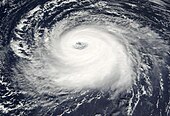
Back عرام العواصف Arabic Daluyong BCL Maror ciclònica Catalan Bouřlivý příliv Czech Stormflod Danish Sturmflut German Marejada ciclónica Spanish Sagailo zikloniko Basque خیزآب Persian Myrskyvuoksi Finnish

| Part of a series on |
| Tropical cyclones |
|---|
 |
|
Outline Media coverage |
| Part of a series on |
| Weather |
|---|
|
|
A storm surge, storm flood, tidal surge, or storm tide is a coastal flood or tsunami-like phenomenon of rising water commonly associated with low-pressure weather systems, such as cyclones. It is measured as the rise in water level above the normal tidal level, and does not include waves.[1]
The main meteorological factor contributing to a storm surge is high-speed wind pushing water towards the coast over a long fetch.[2] Other factors affecting storm surge severity include the shallowness and orientation of the water body in the storm path, the timing of tides, and the atmospheric pressure drop due to the storm.
As extreme weather becomes more intense and the sea level rises due to climate change, storm surges are expected to cause more risk to coastal populations.[3] Communities and governments can adapt by building hard infrastructure, like surge barriers, soft infrastructure, like coastal dunes or mangroves, improving coastal construction practices and building social strategies such as early warning, education and evacuation plans.[3]
- ^ "Storm Surge Overview". nhc.noaa.gov. Archived from the original on 2011-05-25. Retrieved 2023-11-08.
- ^ Yin, Jianjun, et al. "Response of Storm-Related Extreme Sea Level along the US Atlantic Coast to Combined Weather and Climate Forcing". Journal of Climate 33.9 (2020): 3745–3769.
- ^ a b Collins, M.; Sutherland, M.; Bouwer, L.; Cheong, S.-M.; et al. (2019). "Chapter 6: Extremes, Abrupt Changes and Managing Risks" (PDF). IPCC SROCC 2019. pp. 589–655. Archived (PDF) from the original on 2019-12-20. Retrieved 2021-01-31.